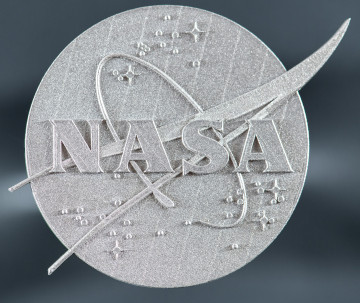
3D Systems verifies performance of NASA’s super alloy on commercial printer
By DE Staff
Additive Manufacturing AerospaceSpace agency’s GRX-810 is 1,000 times more durable at 2000°F than comparable alloys.

NASA logo printed from the space agency GRX-810 super alloy.
(Image credit: NASA/ Jordan Salkin)
3D Systems announced it has verified the properties of NASA’s GRX-810 super alloy using the company’s Direct Metal Printing (DMP) process. According to the company, demonstrating the performance of the material across different equipment and processing parameters opens the door for GRX-810 to be used in various aerospace components that require superior performance to traditional nickel-based superalloys.
“The successful verification of the reported NASA GRX-810 properties is a testament to the incredible potential of this new super alloy, not only in its performance but in its capability to be produced repeatably,” said Dr. Michael Shepard, vice president, aerospace & defense segment, 3D Systems.
While the alloy’s discovery was announced last year, NASA, in conjunction with Ohio State University, recently published a peer-reviewed paper in the journal Nature detailing the super alloy’s metallurgy and performance characteristics. According to the authors, the NASA-developed superalloy has twice the tensile strength, over 1,000 times more creep strength and twice the oxidation resistance compared to other superalloys at temperatures up to 1,093°C (2000°F).
“This superalloy has the potential to dramatically improve the strength and toughness of components and parts used in aviation and space exploration,” said Dr. Tim Smith of NASA’s Glenn Research Center, who is lead author of the Nature paper and inventor of GRX-810, along with Glenn colleague Christopher Kantzos.
According to the NASA paper, GRX-810 owes its resilience to its oxide dispersion strengthened (ODS) composition. Guided by prior research, NASA researchers used the laser powder bed fusion (l-pbf) AM process to coat NiCoCr metal powder with nano-scale oxide particles. The NASA team also employed computer model-driven alloy design to optimize the formation for high temperature applications.
The result is a combination of strength, ductility, creep life and heat resistance, the researchers say, that make GRX-810 ideal for applications such as rocket engines, turbine blades and exhaust nozzle components.
www.3dsystems.com
